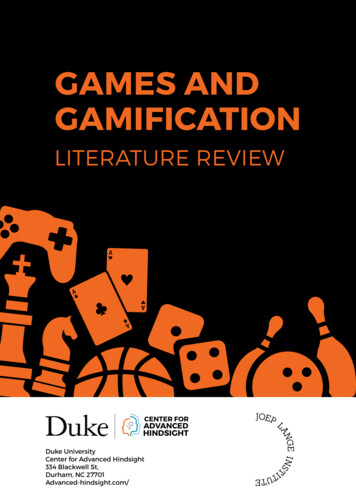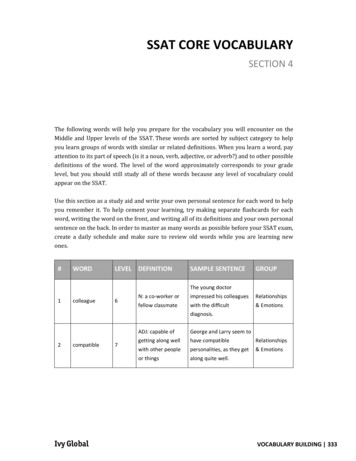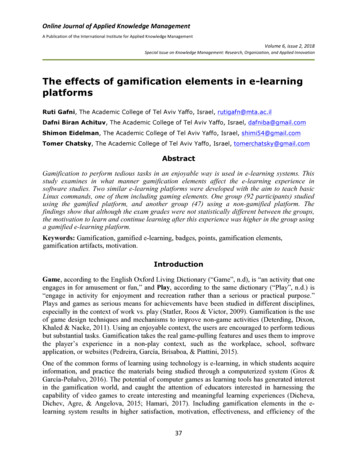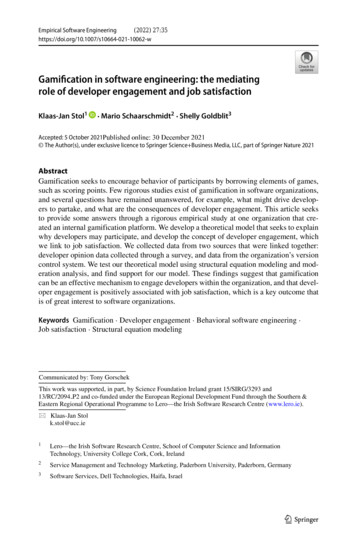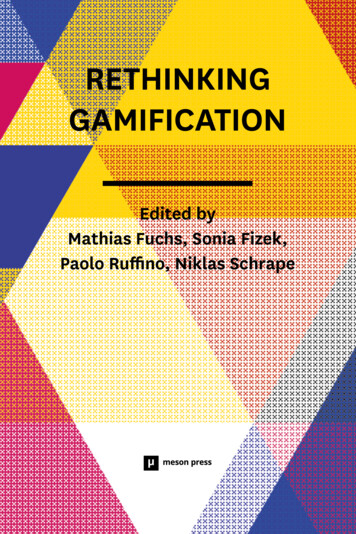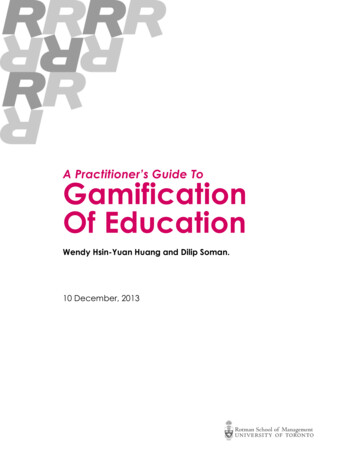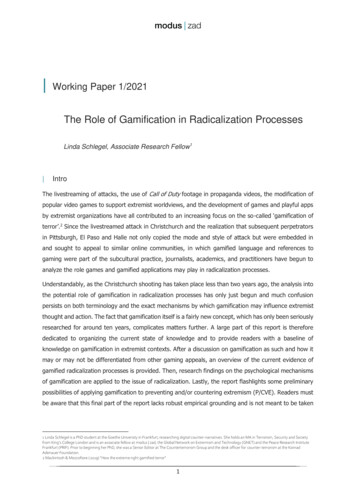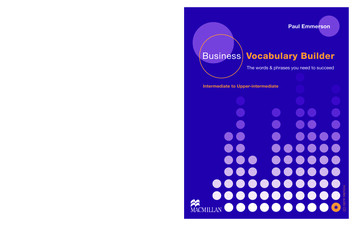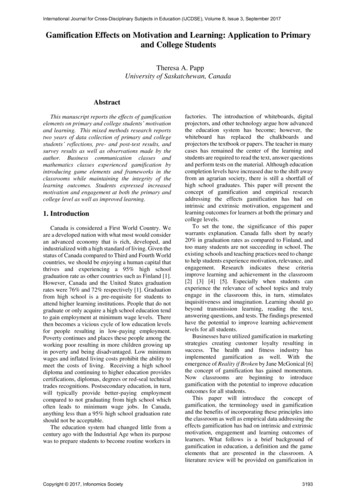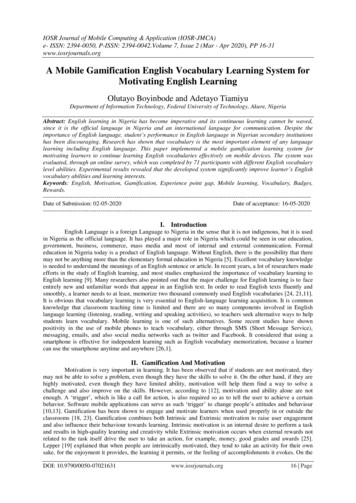
Transcription
IOSR Journal of Mobile Computing & Application (IOSR-JMCA)e- ISSN: 2394-0050, P-ISSN: 2394-0042.Volume 7, Issue 2 (Mar - Apr 2020), PP 16-31www.iosrjournals.orgA Mobile Gamification English Vocabulary Learning System forMotivating English LearningOlutayo Boyinbode and Adetayo TiamiyuDepartment of Information Technology, Federal University of Technology, Akure, NigeriaAbstract: English learning in Nigeria has become imperative and its continuous learning cannot be waved,since it is the official language in Nigeria and an international language for communication. Despite theimportance of English language, student’s performance in English language in Nigerian secondary institutionshas been discouraging. Research has shown that vocabulary is the most important element of any languagelearning including English language. This paper implemented a mobile gamification learning system formotivating learners to continue learning English vocabularies effectively on mobile devices. The system wasevaluated, through an online survey, which was completed by 71 participants with different English vocabularylevel abilities. Experimental results revealed that the developed system significantly improve learner’s Englishvocabulary abilities and learning interests.Keywords: English, Motivation, Gamification, Experience point gap, Mobile learning, Vocabulary, ate of Submission: 02-05-2020Date of acceptance: ----------------------------------- ----------I. IntroductionEnglish Language is a foreign Language to Nigeria in the sense that it is not indigenous, but it is usedin Nigeria as the official language. It has played a major role in Nigeria which could be seen in our education,government, business, commerce, mass media and most of internal and external communication. Formaleducation in Nigeria today is a product of English language. Without English, there is the possibility that theremay not be anything more than the elementary formal education in Nigeria [5]. Excellent vocabulary knowledgeis needed to understand the meanings of an English sentence or article. In recent years, a lot of researchers madeefforts in the study of English learning, and most studies emphasized the importance of vocabulary learning toEnglish learning [9]. Many researchers also pointed out that the major challenge for English learning is to faceentirely new and unfamiliar words that appear in an English text. In order to read English texts fluently andsmoothly, a learner needs to at least, memorize two thousand commonly used English vocabularies [24, 21,11].It is obvious that vocabulary learning is very essential to English-language learning acquisition. It is commonknowledge that classroom teaching time is limited and there are so many components involved in Englishlanguage learning (listening, reading, writing and speaking activities), so teachers seek alternative ways to helpstudents learn vocabulary. Mobile learning is one of such alternatives. Some recent studies have shownpositivity in the use of mobile phones to teach vocabulary, either through SMS (Short Message Service),messaging, emails, and also social media networks such as twitter and Facebook. It considered that using asmartphone is effective for independent learning such as English vocabulary memorization, because a learnercan use the smartphone anytime and anywhere [26,1].II. Gamification And MotivationMotivation is very important in learning. It has been observed that if students are not motivated, theymay not be able to solve a problem, even though they have the skills to solve it. On the other hand, if they arehighly motivated, even though they have limited ability, motivation will help them find a way to solve achallenge and also improve on the skills. However, according to [12], motivation and ability alone are notenough. A „trigger‟, which is like a call for action, is also required so as to tell the user to achieve a certainbehavior. Software mobile applications can serve as such „trigger‟ to change people‟s attitudes and behaviour[10,13]. Gamification has been shown to engage and motivate learners when used properly in or outside theclassrooms [18, 23]. Gamification combines both Intrinsic and Extrinsic motivation to raise user engagementand also influence their behaviour towards learning. Intrinsic motivation is an internal desire to perform a taskand results in high-quality learning and creativity while Extrinsic motivation occurs when external rewards notrelated to the task itself drive the user to take an action, for example, money, good grades and awards [25].Lepper [19] explained that when people are intrinsically motivated, they tend to take an activity for their ownsake, for the enjoyment it provides, the learning it permits, or the feeling of accomplishments it evokes. On theDOI: 10.9790/0050-07021631www.iosrjournals.org16 Page
A Mobile Gamification English Vocabulary Learning System for Motivating English Learningother hand, people become extrinsically motivated is to obtain some reward or avoid punishment. The use ofgame elements increases students‟ motivation because they get fully engaged when faced with a challengingtask. For example, by using extrinsic rewards like levels, points, and badges to improve engagement whileintrinsically motivating towards the achievement, mastery, autonomy, and sense of belonging.III. Related WorkA lot of researches have been conducted on English vocabulary learning and different systems havebeen developed, but most of these systems were developed on PDAs (Personal Digital Assistant) with very fewdesigned to sustain learner‟s motivation. However, PDAs are now expensive and almost out of existence as theyare being replaced by smartphones. Two of the most documented English vocabulary learning system onsmartphones for sustaining learners‟ motivation were implemented by Hasegawa et al. [15] and Lam [17].Hasegawa et al. [15] developed an effective vocabulary learning support system for the learner‟s sustainablemotivation. The system employed gamification techniques and functions to motivate learners to continuelearning; however, the system functions and menus were written in Chinese language, with no translation optionprovided, thereby making it not suitable for non-Chinese speaking persons. Also, the system only focused onbasic or elementary level of vocabulary as the learning material, ignoring other levels such as intermediate andhigh-intermediate.Lam [17] described the use of gamification in Vocabulary Learning: This was to determine if onlinegames could help motivate students in English vocabulary learning in the classroom and as such, two onlinegames were used. It was established that online games improved the vocabulary learning attitude of theparticipants. The research still presented a few limitations. One of such is that the learning procedure wasrestricted to classroom learning alone and also the learning materials were obtained from the students‟ classnotes, thereby making it impossible to learn outside classroom environment. Other works include; Huang et al.[16]) developed a ubiquitous English vocabulary learning system. The system is a ubiquitous Englishvocabulary learning (UEVL) system, designed to assist students in experiencing a systematic vocabularylearning process. Yuksel and Sevil [28] implemented a learning Environment for English vocabulary usingQuick Response Codes. A learning environment that uses tablets and Quick Response (QR) codes to enhanceparticipants. Unlike other ubiquitous learning technologies, study reveals that Quick Response codes have thepotential to increase the mobile devices‟ effectiveness level due to their being flexible tools for obtainingknowledge and promoting individual learning and low cost. Chen and Li [6] presented a personalized contextaware ubiquitous learning system for supporting effective English vocabulary learning. The development ofcontext-awareness system, which can support learners in English vocabulary learning without constraints oftime or place via mobile devices in real learning environment. Chen and Chung [7,8] developed a personalizedmobile English vocabulary learning system based on item response theory and learning memory cycle. Thesystem recommends appropriate English vocabulary for learning according to individual learner vocabularyability and memory cycle. Since English learning has been the most important second language in non-Englishspeaking countries, developing modern assistive learning forms or tools that support effective English learninghas been a crucial issue in the English-language education field. Guoliang et al. [14] presented a research onMobile English Assistant Learning System based on Wireless Communication. It is an English mobile learningsystem based on Bluetooth technology. With the characteristic of portable devices, the system was designed forlow power consumption and low learning cost. With the help of the system, a teacher could receive instantfeedback from the students. This research adopted the use of Gamification mobile learning system to encouragelearners to continue learning English vocabularies effectively.IV. System DesignIn this section, the design of a gamification-based English vocabulary system for improving Englishvocabulary abilities of learners is presented. Details of the system architecture include; the English vocabularylearning procedure, extraction of learning materials, Gamification function used and difficulty level adjustment.The architecture of the system is presented in Figure 1. The system consists of three major modules, with adatabase, and a learning interface. The modules are the vocabulary recommendation module, learningperformance assessment module and test moduleDOI: 10.9790/0050-07021631www.iosrjournals.org17 Page
A Mobile Gamification English Vocabulary Learning System for Motivating English LearningFig. 1. Architecture of the System (Adapted from [7])The vocabulary recommendation module: The module recommends English vocabulary to individuallearner according to the game level of the individual learner (game level). The test module: This moduleautomatically generates a corresponding testing sheet according to the learned vocabularies of individual learnerfor assessing the learning performance. The learning performance assessment module: This module collects thelearner test results from the test module, then re-evaluates individual learner ability of vocabularies. This iswhere gamification comes in. Each test questions generated by the Test module has points attached to them.These accumulated points are what is used by the learning performance assessment module to progress a playerto a new level based on the difficulty level adjustment model. The learning performance assessment module,then stores these information mentioned-above in the user portfolio database for personalized Englishvocabulary recommendation learning. All the English vocabularies stored in the vocabulary database are fromthe repository of Graduate Record Examination (GRE). The system applies the grading level of GRE tocategorize each vocabulary into different game levels. The GRE is divided into three levels with contentappropriate to each level; Basic, Intermediate and Advanced levels. These levels are further subdivided into ten(10) game levels. The Basic level vocabularies forms the first three game level, while the Intermediate levelvocabularies form the next three game levels and the Advanced level vocabularies forms the last four gamelevels. The system consists of a total of 500 vocabularies and 600 test questions.The system operation procedure is summarized as follows:Step 1. Learner logs into the system through the learning Interface. The learning Interface checks the individuallearner‟s profile. If learner is a beginner, it requests for the learner/player to create a profile. The learner startsthe learning process.Step 2. The vocabulary recommendation module obtains the game level of individual learners and all learnedvocabulary from the vocabulary database.Step 3. If a learner is learning for the first time, the vocabulary recommendation module then recommends newvocabulary to the learner.Step 4 and 5.The test module then checks the vocabulary database for questions related to the learnedvocabularies and presents it to the learner as game tasks or challengeStep 6 and 7.The learning performance module assesses the result from the test agent and increases thelearner‟s game level using Experience points gained in a previous level. It then stores this new information inthe vocabulary database.Step 8. Learner returns to Step 2 to perform the next learning cycle or quit the game, thereby terminating thelearning process.A Gamification model was adapted from [22]]and it consists of;a) A set of tasks k K that need to be performedb) A set of game design elements g G, where G is gamificationc) A set of users u U processing task K enhanced by G, where U is the total number of users.A. Gamification FunctionsThe gamification function is designed referring to the digital game-based learning framework proposed by Tanet al. [27] which can be utilized to fulfil the system concept that encourages learners‟ motivation to learn inDOI: 10.9790/0050-07021631www.iosrjournals.org18 Page
A Mobile Gamification English Vocabulary Learning System for Motivating English Learningmobile learning environment. Tan and others proposed a framework in which an educational game wascomposed of three elements; Multimodal, task and feedback. Multimodal refers to a variety of interaction thatconnects a learner and a game, namely, sounds, animations, effects etc. Task refers to a question or problem inthe game to help learner to absorb the learning content (i.e., English vocabulary word with appropriate difficultythat adjusts to learner‟s skills in this case). Feedback for learners is vital in an educational game. A suitablefeedback reduces the learner‟s misunderstanding.B. Difficulty Level AdjustmentsGaming experience begins with tasks or missions that should have clear goals and provide immediatefeedback. These goals should be both challenging and achievable, thus giving rise to various conflicts andchallenges. Too much challenging goals will not be achievable, and easily achieved goals will not bechallenging. Some players will lack the enthusiasm to engage with too difficult or too easy missions, while someothers will classify them as not enjoyable. Ideally, game challenges should increase when the player advances inlevels. As the player becomes more proficient with the game and his/her character becomes tougher, the amountof experience or any other metric needed to advance a level should be more than the amount needed on theprevious leveling up [2,3]. Similar techniques are applied in almost all Role-Playing Games (RPGs) to adjust theexperience point gap for leveling up automatically [4]. The formula is given as:𝑇𝑋𝑃 (𝑁) 𝑇𝑋𝑃 𝑁 1 (𝑃2 𝐶𝐿 )where, 𝑁 New game level𝑇𝑋𝑃 (𝑁) Total Experience points for progressing into level N.𝑇𝑋𝑃 𝑁 1 Total Experience points gained in the previous level.𝑃2 Experience points needed for progressing from level 1 to level 2 which is predetermined𝐶𝐿 Current game level.The formula above is used by the system to calculate the total experience point that is needed for progressing toa new level. The learning Assessment module then compares the score that a particular user gets from solving atask/test question in particular level with the total experience point that is required to move the user from hiscurrent level to a new level. If the user‟s score equals the total experience point, the user is progressed to thenew level or else the user remains in the same level and retakes the learning process for that level.C. System ImplementationThis section explains the implementation of the English vocabulary learning system. Currently, allclient-side program code is implemented using HTML5, CSS3 and JavaScript. The server-side scripts wereimplemented using PHP 7.0 (Pre-Processor Hypertext Processor). The backend i.e. database, was implementedusing MySQL. Other tool includes; Website2apk converter (Android Mobile application software developmenttool). The system is available as a mobile web application and also as an android application. Figure 2 showsthe login page.Fig. 2. Login pageDOI: 10.9790/0050-07021631www.iosrjournals.org19 Page
A Mobile Gamification English Vocabulary Learning System for Motivating English LearningAfter successful login, the user is taken to the learning page shown in figure 3, which contains thevocabularies to be learnt, a NEXT and PREVIOUS button for navigating through the vocabularies. The top-rightcorner contains boxes for the player level and the player score. Also, attached to each vocabulary, is a speakerbutton. This button, when clicked, pronounces the corresponding vocabulary and its meaning. When the lastvocabulary for a particular level is reached, the NEXT button changes to TAKE TEST button (see figure 3).This button is used to navigate to the test page for the user to answer the test questions relating to the learntvocabularies as seen in figure 4. The top-left corner shows a side bar button, navigation menus such as, Profile,Leaderboard, About and Logout. This side bar button is consistent on all other pages in the application. Thispage allows users to take test relating to the learnt vocabularies. When a user clicks the TAKE TEST buttonfrom the learning page, the system opens a pop-up containing instructions about the test to be taken for users toanswer. The test consists of ten questions and four options which are loaded one per page and also presented atrandom to the user. On answering each question, the user is shown if each selected answer is correct or wrongvia a pop-up alert and a progress bar (Figure 4). If the user answers all the questions in a particular level, thesystem moves the user to the next level and a badge is earned (see Figure 4i) else the user remains on the samelevelFig. 3. Learning pageDOI: 10.9790/0050-07021631www.iosrjournals.org20 Page
A Mobile Gamification English Vocabulary Learning System for Motivating English LearningFig.4.Testing pageFigure 5 shows the result of the test taken by a user. It contains information like the total questions fora particular level, number of correct answers, number of wrong answers and the player‟s score. It also containsbuttons for replaying a particular level and also for reviewing test question for a particular level.DOI: 10.9790/0050-07021631www.iosrjournals.org21 Page
A Mobile Gamification English Vocabulary Learning System for Motivating English LearningFig. 5. Result pageFigure 6 shows information about a user. This information include input supplied by a user duringregistration, such as player name, email address, and profile picture. Also, it contains information about the userprogress such as, user level, score, badge earned in the current level, achievement. Lastly, it contains buttons forediting user profile.Fig. 6. User profileThe leaderboard page shows the list of users with top five high scores. This page is aimed to motivatethe user to keep learning through the application by wanting to be part of the top five scores in the system. TheLeaderboard page is depicted in Figure 7.DOI: 10.9790/0050-07021631www.iosrjournals.org22 Page
A Mobile Gamification English Vocabulary Learning System for Motivating English LearningFig. 7. Leaderboard pageV. Learning Scenario For Mobile Gamification English Vocabulary Learning SystemA scenario of the learning process is presented here. A sample user with username “Jonny” is a newuser with low English vocabulary ability and he wishes to use the developed application to learn and improvehis vocabulary ability. Jonny logs into the system with his registered email address and the learning page ispresented to him, containing a side bar and the first vocabulary to be learnt at the first level (level 1) as shown infigure 8. The user starts from level 1, he has no score and badge yet, till he progresses in the game. Thevocabulary word “Concede” is first presented to the user with its meaning, synonyms, antonyms, examplesentence and a speaker button to listen to the word pronunciation. When Jonny clicks the “Next” button, he‟spresented with another word, till he reaches the last word to be learnt on level1 (see Figure 8).Fig. 8. Jonny learning vocabularies at level 1On clicking the “Take Test” button, the user is taken to the test page where he is first presented withinstructions on taking the test (see Figure 9) and then, questions related to the learnt vocabularies presented tohim so as to test his memorization ability. The first Question is about the vocabulary word “CONCEDE” (seeFigure 8) which has been previously learnt on the learning page. Four options are provided for the user fromwhich he selects a correct answer. If Jonny gets a question right, a feedback is shown to him to notify him thathe got it correctly (see Figure 9c) and if he gets it wrong a feedback is also provided for that (Figure 9e). AsJonny clicks the Next button, the next question, which asks about the synonyms of the word “CONCEDE” isprovided for him to answer (see Figure 9d). On getting to the last question, the “Next” button changes to “GetDOI: 10.9790/0050-07021631www.iosrjournals.org23 Page
A Mobile Gamification English Vocabulary Learning System for Motivating English Learningresult”, which when clicked shows the result of the test Jonny (see Figure 9g). The results consist of informationsuch as, Number of correct answers, Number of wrong answers, score, and Total number of questions (as shownin Figure 9g). If Jonny answers all questions in level 1 correctly, he earns a badge and moves to level 2 (seeFigure 9i) else he remains in level 1 and earns no badge (Figure 9h).Fig. 9. Jonny taking a test at level 1Since the user undergoes the same learning process for all the levels in this application, only few gamelevels such as; level 1, level 7 and the last level (level 10) are depicted in this scenario. At level 7, Jonny ispresented with the vocabulary word “PANDEMONIUM” (see Figure 10(a)), “FLABBERGAST” (see Figure10(b)), and “REPLICA” (see Figure 10(c)), with their details.DOI: 10.9790/0050-07021631www.iosrjournals.org24 Page
A Mobile Gamification English Vocabulary Learning System for Motivating English LearningFig. 10. Jonny learning at level 7After Jonny is done learning the vocabularies, he clicks the “TAKE TEST” button and then is taken tothe test page. The first question presented to him is on the vocabulary word “FLABERGAST” (Figure 11(a)).Figure 11(b) shows the feedback when he selects a wrong option while answering the question. Question 3 (seeFigure 11(c)) asks about the antonym of “FLABERGAST”. Figure 11(d) shows a feedback that Jonny got theanswer to question 3 correctly. Also, question 7, which is on the vocabulary word “REPLICA” is depicted inFigure 11(e) and a feedback that the user answered it correctly is also shown in Figure 11(f). The result of thetest taken by the user at level 7 is shown in Figure 11(g). The result shows the number of correct answers he got,number of wrong answers, total number of questions and his score. Finally, a feedback to show that Jonny failedto progress to the next level is shown in figure 11(h) and on subsequent attempts, he finally progresses to thenext level (see Figure 11(i)).DOI: 10.9790/0050-07021631www.iosrjournals.org25 Page
A Mobile Gamification English Vocabulary Learning System for Motivating English LearningFig. 11. Jonny taking a test at level 7On reaching the last level (level 10). Jonny is first presented with the vocabulary word “Malleable” see figure12.Fig. 12. Jonny learning vocabularies at level 10DOI: 10.9790/0050-07021631www.iosrjournals.org26 Page
A Mobile Gamification English Vocabulary Learning System for Motivating English LearningNext is the word “Scrutinize” and another is “Diffident”. After completing the vocabularies learning, he thenproceeds to take a test on the learnt vocabularies. Some of the questions presented to the user at this stage, withtheir appropriate feedback is shown in Figure 13(a), 13(b), 13(c), 13(d), 13(e), and 13(f). The result is shown inFigure 13(g). Because the user took the test on the last level, if he answers all questions correctly, he will notmove further to a new level, instead, a feedback that shows he has successfully completed all levels in the gameis presented to him, as shown in Figure13(h).Fig. 13. Jonny takes a test at level 10 (last level of the game).DOI: 10.9790/0050-07021631www.iosrjournals.org27 Page
A Mobile Gamification English Vocabulary Learning System for Motivating English LearningVI. Application EvaluationThe evaluation and effects of the system was carried out through actual use and a survey form attachedto the developed application (see figure 14). The survey was completed online by 71 participants, consisting of41 Males and 30 Females. The participants used different vocabulary level ability (i.e. Basic, Intermediate, HighIntermediate level). The participants answered the survey for each function on a scale of five, three and one.Five is allocated to “Agree”, Three is allocated to “Neither agree nor Disagree”, and one is allocated to“Disagree”. The content of the survey and its result is shown in Table 1 below. Figure 15 shows the Graph ofthe survey performance.Fig.14.Online survey formContent1.The application is easy to use2.The application has a friendly User Interface3.The application provides Clear points and Ranking System4.The application provides a good feedback system5. The Learning procedure is easy to understand6.The application has efficient difficulty level settings7.I love the Time trial challenge provided by this application8.I love the Rewards and Badges given by this application9.The application has clear learning Instructions10.The application motivates me to learn English vocabulary themore11.I enjoyed playing with this applicationAgree69 (97.2%)70 (98.6%)67 (94.4%)66 (93.0%)64 (90.1%)60 (84.5%)59 (83.1%)68 (95.8%)66 (93.0%)67 (94.4%)Neither Agree norDisagree2 (2.8%)1 (1.4%)3 (4.2%)2 (2.8%)7 (9.9 %)5 (7.0%)10 (14.1%)3 (4.2%)4 (5.6%)3 (4.2%)Disagree0 (0%)0 (0%)1 (1.4%)3 (4.2%)0 (0%)6 (8.5%)2 (2.8%)0 (0%)1 (1.4%)1 (1.4%)64 (90.1%)7 (9.9%)0 (0%)Table 1. Summary of users‟ responses to online surveyAccording to these results, many participants indicated “Agree” for most of the contents, however theresults are presented for the 11 contents.Content 1: Ease of use, has the second highest number of “Agree” responses (97.2%), 2.8% number of“Neither Agree nor Disagree” responses and no “Disagree” response. This shows that the users really find theapplication easy to use.Content 2: User friendly interface, received the highest number of “Agree” responses (98.6%), thelowest number of “Neither Agree nor Disagree” responses (1.4%) and no “Disagree” response too. This showsthat users find the Interface very attractive and interactive.DOI: 10.9790/0050-07021631www.iosrjournals.org28 Page
A Mobile Gamification English Vocabulary Learning System for Motivating English LearningContent 3: Clear points and ranking system, also received a high number of “Agree” responses, with 94.4% ofthe users agreeing, 4.2% “Neither Agree nor Disagree” and only 1.4% of the users disagree. Therefore, it isbelieved that the system provides clear points and good ranking system.Content 4: Good feedback system, received 93.0% “Agree” responses, 2.8% “Neither Agree nor Disagreeresponses” and 4.2% “Disagree” responses. Thus, it can be concluded that the users are satisfied with the qualityfeedback the application provides.Content 5: Which is aimed at knowing if the learning procedure is easy to understand also received high“Agree” responses (90.1%) and no “Disagree” responses. This shows that the participants found the learningprocedure easy to understand.Content 6: Efficient Difficulty level Settings received the highest “Disagree” responses, although, it alsoreceived a high number of “Agree” responses. This might be due to the fact that users were required to answerall questions in a particular level correctly before they can move up to a new level and as such, some users felt itwas too difficult to move up the game levels.Content 7: Time trial challenge, received the lowest number of “Agree” responses and the highest number of“Neither Agree nor Disagree” responses in the survey. It is considered that the time the users were provided tocomplete a task or challenge was too little and thus, some were unable to complete a particular level.Content 8, Good Rewards and badges, received the third highest number of “Agree” response and no “Disagree”response, which showed that users really loved the rewards and badges given by the application.Content 9: Clear learning instructions, received 93.0% “Agree” responses, 5.6% “Neither Agree nor Disagree”responses and 1.4% “Disagree” responses. Therefore, it is believed that learners understood clearly the learninginstructions given by the application.Content 10: “Motivation” also received a high number of “Agree” responses and few “Disagree” responses. assuch, they were motivated by the application to keep learning English vocabulary the more.Content 11: “Enjoyment” also received a high number of “Agree” responses and no “Disagree” responses. Thisshowed that users enjoyed playing with the application.This system, when compared with other existing e-learning systems in the literature using someperformance metrics showed a high performance as against other related works.
Lam [17] described the use of gamification in Vocabulary Learning: This was to determine if online games could help motivate students in English vocabulary learning in the classroom and as such, two online games were used. It was established that online games improved the v
